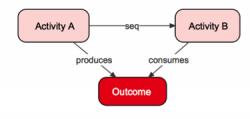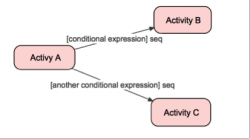Eigenschappen
| Context | Expertise Management Method (EMM) |
|---|---|
| prefLabel | |
| altLabel | |
| hiddenLabel | |
| inScheme | |
| subject | |
| broader | EMontPatronen |
| narrower | |
| partOf | |
| association | |
| related | |
| creator |
De View-Navigation (VN) pagina's.
Er zijn geen VN pagina's gelinkt.
Description
The PQR formula has already been discussed in great detail in another part of the wiki, however, the pattern and how it's visualised is hardly discussed. This page about the PQR pattern aims to inform of the way PQR is visually structured within the EMont. PQR is an extremely important part of the Expertise Management Ontology, as mentioned before: It’s considered to be the working horse of the EMont. The PQR pattern is widely used in the EMont and it can be used in multiple different situations due to the way it has been set up.
Using the PQR method will generate numerous different approaches to reach a certain result. In some contexts it’s better to choose one of those actions, but other times it might be better to execute all the actions sequentially. This is where the major distinction in PQR visualisations comes in; the freedom of getting to choose which action is the most appropriate is labeled as the ‘Degree of freedom’, whilst executing the activities one after another is called ‘Sequencing of activities’. This means that when a high degree of freedom is present, there will also be lots of actions to choose from, depending on the situation; this might or might not be ideal. When sequencing activities, there is not much room for freedom, the relevant activities will be done in a certain order, no questions asked. The results of a PQR implementation is a ‘use case map’, which is essentially a timeline which denotes the activities that need to take place to reach a certain goal. There are multiple types of activities that are used in a concept map, the different types are:
- A sequential execution of activities means that all activities are done one after another. The next activity can't be started until the previous activity has been completed. In the context of flood protection, it could be the case that a dike has to be heightened, after that has been done, a test can be ran; but the test can't be performed until the dike has been heightened.
- A conditional execution means that a certain condition has to be met before an activity can start. For example it could be that an activity is to construct a dike, but before that can happen, money needs to be raised. The condition in the case is: Half a million euros are required. The activity 'build a dike' can't start until this condition has been met.
Parallel activities are executed alongside each other; this means that both of the activities will be executed at the same time, running parallel. For example; while building a dike, it's also possible to finish certain paperwork, it wouldn't make sense to wait until everything is done to finish this, so they are executed simultaneously. This does not necessarily mean that both activities have to work towards the same goal.









